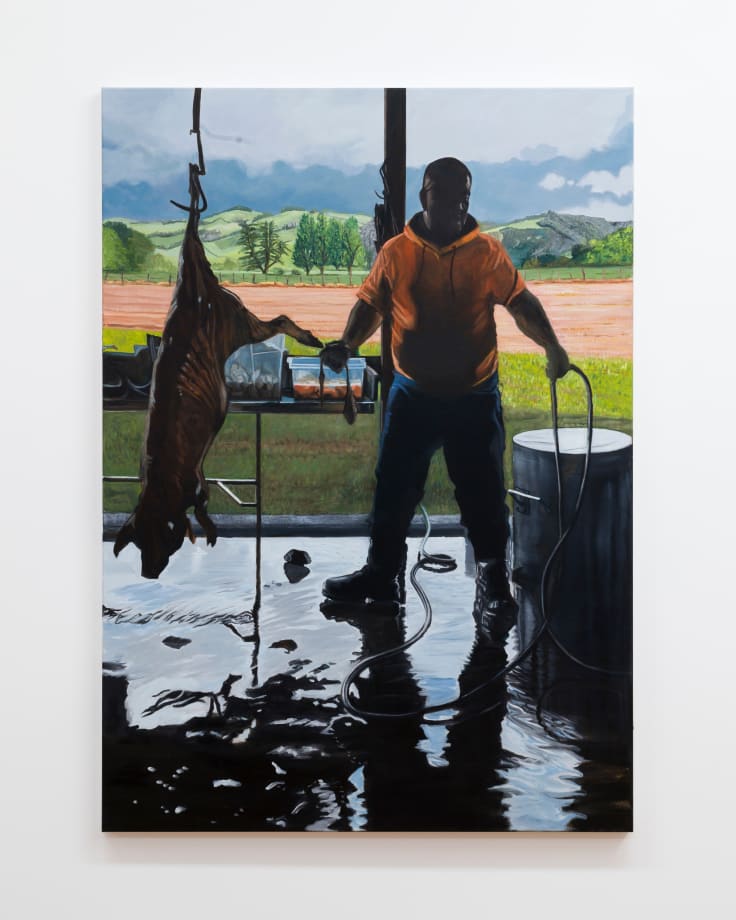Hiria Anderson-Mita (b.1974, Ngāti Maniapoto, Ngāti Apakura, Ngāti Rereahu) paints from her home studio in Ōtorohanga, where the artist’s koro and nanny raised their children and later their granddaughter. Creatives in the traditional forms of Mahi Raranga and Whakairo, her grandparents were involved in Ngā Puna Waihanga, a network of Māori artists, writers, and makers that emerged in the 1970s. From a young age Anderson-Mita was deeply immersed in this artistic community, often accompanying her grandparents up and down the motu, and this early exposure to different art forms was highly influential, eventually leading to her joining the association and later enrolling in Te Kura Toi - Visual Arts tutored by James Ormsby and Eugene Kara, where she studied painting, drawing, sculpture, and art history.
Anderson-Mita surveys her immediate surroundings and those individuals and relationships within her small community through her painting practice, set against the backdrop of wider issues and contemporary politics. While on one hand these works are deeply personal, on the other they extend far beyond the artist and her own immediate relationships. “I paint about those things that are affecting our people.” The artist captures in detail the intimacy, incongruity, and poeticism of the everyday and with it the interplay between tikanga Māori and contemporary municipal life. While her works regularly convey bustling activity, they are equally occupied by a sense of absence; painstakingly depicting figures from obscure viewpoints, vacant spaces, or the minutiae of discarded objects.
Te Hokinga Mai translates as The Return and references how us as a people and whānau are guided by the principles of our culture that return us back home to our ancestral lands. To bury our dead, to gather, to cook and feed each other, to karakia. I show glimpses of the last few months. For me personally Te Hokinga Mai means I am returning home where I came from.
Michelle Rahurahu (Ngāti Rahurahu, Ngāti Tahu-Ngāti Whaoa) has written a response to Te Hokinga Mai, which you can below. Rahurahu is a writer and co-editor of Te Rito o te Harakeke, an anthology of Māori voices for Ihumātao, she has a Masters in Creative Writing from the IIML where she won the Modern Letters Fiction Prize, and was shortlisted for the Michael Gifkins Prize for her novel manuscript Pōhara.
Anderson-Mita surveys her immediate surroundings and those individuals and relationships within her small community through her painting practice, set against the backdrop of wider issues and contemporary politics. While on one hand these works are deeply personal, on the other they extend far beyond the artist and her own immediate relationships. “I paint about those things that are affecting our people.” The artist captures in detail the intimacy, incongruity, and poeticism of the everyday and with it the interplay between tikanga Māori and contemporary municipal life. While her works regularly convey bustling activity, they are equally occupied by a sense of absence; painstakingly depicting figures from obscure viewpoints, vacant spaces, or the minutiae of discarded objects.
Te Hokinga Mai translates as The Return and references how us as a people and whānau are guided by the principles of our culture that return us back home to our ancestral lands. To bury our dead, to gather, to cook and feed each other, to karakia. I show glimpses of the last few months. For me personally Te Hokinga Mai means I am returning home where I came from.
Michelle Rahurahu (Ngāti Rahurahu, Ngāti Tahu-Ngāti Whaoa) has written a response to Te Hokinga Mai, which you can below. Rahurahu is a writer and co-editor of Te Rito o te Harakeke, an anthology of Māori voices for Ihumātao, she has a Masters in Creative Writing from the IIML where she won the Modern Letters Fiction Prize, and was shortlisted for the Michael Gifkins Prize for her novel manuscript Pōhara.

